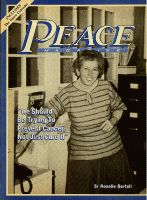
Peace Magazine May 1985, page 9. Some rights reserved.
Search for other articles by Roy McFarlane here
OTTAWA-- In an informal address at Ottawa's Peace Resource Centre on April 12, the Executive Director of the Canadian Institute for International Peace and Security (CIIPS) spoke about the media distortions between the East and the West, and about the relationship between the newly-formed institute and the Canadian peace movement. Geoffrey Pearson, until last year the Canadian ambassador to the Soviet Union, drew attention to the way in which the western media misrepresents the Soviets. He also said that, in his three years of reading Soviet newspapers, he found similar distortions in their view of the West.
He said that, after returning to Canada, he would have liked to spend some time correcting some of these distortions despite the risk of being labelled a "fellow-traveller."
Pearson also spoke about the reservations some people had about his appointment to Executive Director of CIIPS. "I have been identified with the government most of my life," he said, "and there are a lot of people in the peace movement who think that, by definition, government officials (should) not be in charge of something like this. There is a view that government officials are cut off from the public and can't communicate well."
He noted, however, that "there was another point of view. I had just spent three years in the Soviet Union. I'm sure there were some people who though that 'well, maybe he's come back too liable to reflect the views of the Soviet Union'." Nevertheless, after three months of discussion, Pearson's appointment was approved unanimously by the three federal political parties this past December; his term is to last until January 1987.
Pearson devoted much of his talk to a clarification of the agenda of CIIPS. According to the Act of Parliament which created the institute, there are four areas which the institute is to deal with: arms control, disarmament, defence and conflict resolution.
Pearson explained that, as the institute is in its formative stage, its members are now discussing how CIIPS should cover these areas. "Are we going to look at conflict resolution in general, or are we going to look at specific examples? Are we going to look at current schemes for disarmament or arms control, or are we going to look at the perfect world? We look ahead, but if we look too far ahead we won't have any impact on what governments are doing today."
Pearson also outlined the four functions of the institute: collecting information, distributing information, fostering research and education, and suggesting proposals for government policy.
The institute will attempt to reach four audiences: the public, the scholarly community, the government and the international audience.
Pearson invited suggestions on the relationship between peace resource centres, such as the one he was addressing, and the institute, and asked whether the centres should have access to funds from CIIPS. He noted the large number of such entities across Canada, and the shortage of funds which can be used for this purpose. "You don't want $100 or perhaps you do -- but that wouldn't help you very much. Should there be a national network through which you work?" He added that the institute is "trying to do what we can with limited resources in the best possible way which will be seen as fair."